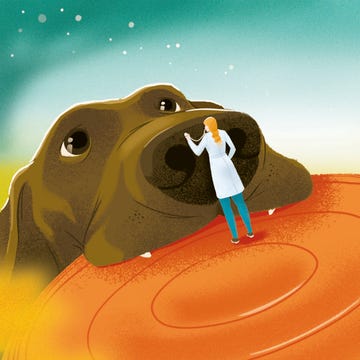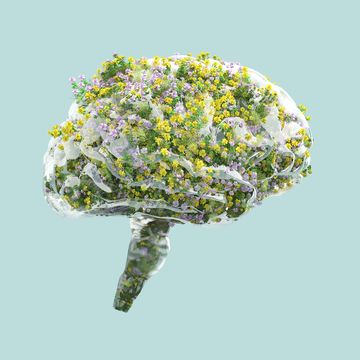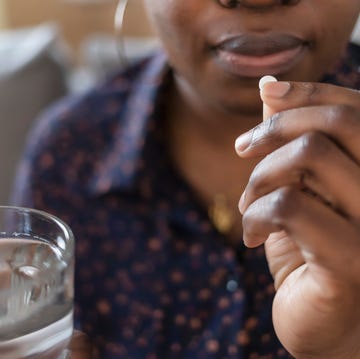Ask the oldest people you know, “What’s the secret to longevity?” and you’ll get some interesting answers. A daily dish of chocolate ice cream or shot of whiskey? A job one loves or plenty of friends? Scientists ask the question too, studying the habits of centenarians across the world for the keys to living as long as possible.
But as they say, aging isn’t for cowards: It often comes with an aching, fragile body and mental decline. So along with figuring out how we can live longer, researchers have been peering deep into our cells to figure out how to keep us living better. They’re envisioning a not-too-distant future in which humans will thrive well into their 90s and beyond, free of chronic diseases and age-related decline such as fading eyesight and dementia.
While we may still be a ways off from a world of miraculously youthful 100-year-olds, this booming field of research is providing us with solid info we can use right now on how to slow down the clock and live our best lives in our 60s, 70s, 80s, and beyond. “We’re at a point where we know there are genes that control the aging process,” says David A. Sinclair, Ph.D., codirector of the Paul F. Glenn Center for Biology of Aging Research at Harvard Medical School and author of Lifespan: Why We Age and Why We Don’t Have To. “We know we can intervene and slow the process down—even in humans.”
Indeed, we have quite a bit of influence on our aging based on our everyday health behaviors, says Morgan Levine, Ph.D., an assistant professor of pathology at the Yale School of Medicine and author of the forthcoming book True Age: How Cutting-Edge Research Can Help You Turn Back the Clock. Aging occurs because our cells change over time and the body’s repair mechanisms lose the ability to fix them, which leads to the diseases we ultimately die from. But you can slow down those processes with these proven biohacks, which can help you feel better as long as you live.
Strengthen the armor that protects your cells
Telomeres are the protective caps at the ends of each strand of DNA (think of them as being like the little plastic tips on the ends of your shoelaces), and they affect how quickly your cells—and you—age. When telomeres are too short, the cells stop working and become “zombie” (or “senescent”).
In this state, they emit molecules that promote inflammation and peptides that accelerate aging. This doesn’t lead to any particular disease, but it means you may succumb more quickly to whatever your genes and environment put you at risk for, whether it’s heart disease, dementia, or cancer. However, research shows that you can reverse many aspects of aging if you can prevent cells from becoming zombified.
One of the best ways to grow your cellular armor is to get moving; exercise stimulates the production of the enzyme telomerase, which helps build up telomeres, says Nir Barzilai, M.D., founding director of the Institute for Aging Research at the Albert Einstein College of Medicine in Bronx, NY, and author of Age Later: Health Span, Life Span, and the New Science of Longevity.
In a Brigham Young University study of more than 5,800 men and women, those who jogged for 25 to 40 minutes five days a week developed telomeres the length of those in people nine years younger. In another small study, the telomeres in women classified as obese also grew after eight weeks on a resistance training and aerobic exercise regimen. And a review of several studies of athletes over 35 (they had competed for an average of 16 years) found that they had longer telomeres than nonathletes the same age.
Exercising your inner strength through meditation can also help protect your telomeres—researchers theorize that it may reduce damaging inflammation. In a 2013 Harvard study, practitioners of loving-kindness meditation, which includes a focus on warmth toward others, had significantly longer telomeres than people who didn’t meditate. UC-Davis researchers also showed that people who meditated for three months had greater telomerase activity than those in a control group.
Boost your built-in survival mechanism
For decades, longevity researchers have known that mice on low-calorie diets live longer than those who eat more mouse chow. In humans, the equivalent benefit can be achieved through intermittent fasting (IF), an eating strategy in which you limit your food intake to certain hours of the day or certain days of the week, says Sinclair. He explains that IF may prolong life by tapping into a process that allowed early humans to survive in times of food scarcity: Hunger raises levels of a chemical called nicotinamide adenine dinucleotide (NAD), which activates longevity genes known as sirtuins, Sinclair says. Sirtuins protect against disease, boost the repair of DNA, and quell the inflammation behind arthritis, atherosclerosis, asthma, and other chronic conditions.
IF is clearly not for everyone; it requires strict discipline and can mask an eating disorder, so be sure to check with your doctor before you attempt it. “People who are treated with insulin and some hypoglycemic agents should not do it,” says Dr. Barzilai.
But many people can adjust to the regimen, he says. It doesn’t seem to matter which of the multiple IF variations you practice. Some people eat a significantly restricted diet five days a month; others fast two days a week, consuming about 500 calories on fasting days (called the 5:2 method), or restrict eating to a six- to 12-hour window during the day (eating only, say, from noon to 6 p.m. or from 9 a.m. to 9 p.m.), which is called time-restricted eating (TRE). The shorter the window in which you eat, the better for optimizing this anti-aging mechanism, which Sinclair says activates the body’s natural defenses against deterioration and chronic disease.
Turn on the longevity switch in your DNA
Unlike your chronological age (how many birthdays you’ve checked off), your biological age shows how well your body is holding up against the ravages of time and how you compare with others who’ve lived the same number of years. At 40 you could have a biological age of anywhere from 30 to more than 50 based on your genes, habits, and environment. But whatever your biological age is, you have the ability to improve it, says Levine.
Several pilot studies suggest that diet and other habits can move biological age in the right direction. In a recent European study, people who spent a year on the Mediterranean diet, which emphasizes vegetables, fruit, fish and other lean proteins, nuts, legumes, and olive oil, lopped almost 1.5 years off their biological ages. In another study, 18 healthy men were put on an eight-week lifestyle regimen designed to optimize DNA methylation, a chemical reaction that affects how genes are activated. The result: They lowered their biological ages by over three years compared with a control group, according to the journal Aging. The men ate leafy greens and cruciferous vegetables along with other foods known to promote favorable methylation patterns (including beets, pumpkin seeds, berries, eggs, liver, and garlic).
They also worked out, took a probiotic, practiced breathing exercises, and tried to get at least seven hours of sleep each night. The lifestyle tweaks paid off. “This is one of the first studies to show a reversal in biological aging,” says Kara Fitzgerald, a naturopathic doctor and lead author of the study and of the forthcoming book Younger You.
Another way to reverse that biological clock: Eat less animal-based protein. While men need only about 56 g of protein a day and women 46 g, the average American eats around double that amount. Longevity studies show that consuming too much protein can activate an enzyme called mTOR that accelerates aging. Try limiting meat servings to 3 or 4 oz (the size of a deck of cards), and swap in more plant-based protein sources like beans and soy.
Shock your system into resetting itself
Ever wonder why someone would take a “polar bear plunge” into frigid water on New Year’s Eve? Beyond the thrill, the brief exposure to extreme temperatures actually stresses cells, challenging them to adjust to the change and bring the body’s temperature back to normal. Like intermittent fasting, this type of stress activates the longevity genes known as sirtuins. You can get similar benefits by leaving windows open at night in the winter or exercising in the cold. Simply taking a quick walk in frigid temperatures while wearing a T-shirt but no coat can apply this “good” stress to your system. (Keep it brief, though—go for just three or four minutes, bundling up again before you start shivering, says Sinclair.)
And it’s not just about getting cold: Research suggests that heat also mildly stresses the body in favorable ways. Middle-aged men in Finland who took a sauna four to seven days a week for 20 years had a twofold drop in death from any cause, along with a reduction in fatal heart attacks and heart disease in general, compared with men who used a sauna only once a week. For a double dose of longevity-triggering stress, do as Sinclair does: “I like going from a sauna as hot as I can bear into an ice-cold tub for four minutes,” he says.
You can also stress your body’s cells with high-intensity interval training (HIIT), an exercise strategy that involves short, intense bursts of all-out activity followed by rest. “When you’re in a high-intensity interval, it temporarily throws your body out of homeostasis, which is a state of equilibrium defined by temperature, heart rate, and other factors,” says Levine. Then your body works to recover its equilibrium. “Over time, these cycles of stress and response will make you stronger and more resilient,” she explains. Just don’t try to do too much too soon, particularly if you haven’t been active, and tailor the bursts to your current activity level. If you’re a walker, for instance, alternate 10- to 30-second spurts of fast walking with longer periods at your normal pace.
There’s nothing sci-fi about any of these strategies—you can exercise, eat vegetables, and take a sauna today. But if you make these regular habits, perhaps one day you will be able to tell your great-great-great grandkids all about it.
Coming up: A pill to stay young?
Researchers are developing many intriguing new methods of slowing age-related decline. “Some of these approaches are not going to turn out to be relevant for humans,” says Steven N. Austad, Ph.D., senior scientific director for the American Federation for Aging Research. “But there are enough leads that some of them will work, and when we discover which ones do, they will revolutionize medicine like nothing since antibiotics.” Here, some of the most promising therapies in the works.
Replacing old blood with new
“We know from a number of studies that if you transfuse old mice with the blood of younger mice, it rejuvenates the brain, heart, and muscles,” says Austad. While this may sound like the plot of a vampire movie, it’s not quite what you think: Scientists are working to find out which components of blood are the important ones, and eventually those may be available in pill form, Austad says, such that you wouldn’t need a transfusion from your grandchild to get the anti-aging benefit.
Restoring cells to a healthier state
The latest buzz in longevity focuses on efforts to return cells to younger versions of themselves, minus the accumulated aging-related damage. Scientists are using the “backup” copy of cells’ epigenomes—essentially their software—to pull off that mind-bending feat. In 2020, Sinclair’s lab reversed the age of optic nerves and restored vision in aging mice.
Creating age-reversing drugs
At least a dozen new drugs to slow aging are now in human trials, says Austad, who predicts that some will hit the market within 10 years. Several have already been approved for other uses but show promise for extending life and health. In a large industry-funded study of British people with and without type 2 diabetes, those who were taking metformin (a diabetes medication) lived 15% longer on average than healthy people not taking it. And in a pilot study from the Mayo Clinic, patients with kidney disease showed a reduction of senescent cells, which produce harmful inflammation, when treated with an existing drug combined with the drug quercetin, which is also a nutrient in some fruits and vegetables.
















